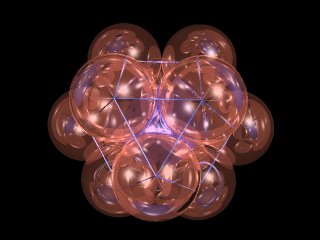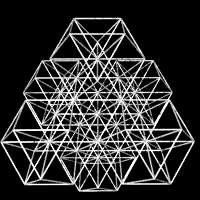SPHERE PACKING STUDIES
Synergetics takes up the subject of spheres packed tightly
together. Mathematicians have not yet reached consensus on a proof
that a Barlow packing, including the face-centered cubic
(fcc) and hexagonal (hcp) is actually the densest
possible, although Gauss proved the fcc's density of approximately
0.74 optimal for a lattice (any denser arrangement would have to be
more random).
The fcc packing is easily described in terms of adding successive layers of spheres to a tetrahedron. Canon balls and fruits in the grocery store are typically stacked in this fashion. A single orange nestles in the "valley" formed by three below it. A triangular layer of six oranges underlies that one and so on. Each layer adds a certain number of oranges, which may be expressed as a function of the growing tetrahedral shape's 'frequency'. The frequency is equivalent to the number of intervals between oranges along the tetrahedron's edge.
* * * *
* * * * * *
* * * * * *
* * * *
Fig. 1. Tri-ville Packing (or Pool Ball)
Kepler studied sphere packing pretty intensely and knew that you get the same fcc packing if you start with a layer of spheres packed in a square arrangement and nest the next layer in the valleys so formed. If you taper off as you go upwards, this looks kind of like a Mayan Temple, so I call it "Mayan temple packing".
* * * * * * * * * *
* * * * * * * * *
* * * * * * *
* * * *
Fig. 2. Squares-ville Packing (or Mayan Temple)
As Jim Morrissett pointed out to me during an IRC chat one morning, the Mayan temple packing forces the fcc, whereas the pool ball packing does not. This is because a "squares-ville" layer presents only one set of valleys for the next layer of spheres, whereas a "tri-ville" layer presents twice as many valleys as we will find usable -- presents an alternative, allowing us to go for hcp instead of fcc or some other Barlow packing.
The table below has a slightly different focus from Fuller's in Synergetics in Synergetics Principles ( section 220.00). Fuller's 2nd power derivations were of the form 2 p ff + 2 where 2 p is the number of non-polar vertices (V-2). This expresses the number of spheres in the outer layer of a shape as a function of frequency. Below, the focus is on the number of spheres added as a shape grows in size, versus the number of spheres exposed on a surface. For example, a tetrahedron starts with a nuclear sphere, and then an expanding base of 3, 6, 10... new spheres per layer.
 |

